This website has been archived from TrainWeb.org/girr to TrainWeb.US/girr.
This website has been archived from TrainWeb.org/girr to TrainWeb.US/girr.
 This page describes the construction of a
scratch built warehouse building in approximately 1:32 scale. The
warehouse has two loading docks, the one on the short side is for
trucks and the longer one parallels a siding where freight would be
transferred to railcars from the stock stored in the warehouse. There
are a few windows in a corner where the office is, but other than that,
there are just several sets of double doors leading out to the
docks.
This page describes the construction of a
scratch built warehouse building in approximately 1:32 scale. The
warehouse has two loading docks, the one on the short side is for
trucks and the longer one parallels a siding where freight would be
transferred to railcars from the stock stored in the warehouse. There
are a few windows in a corner where the office is, but other than that,
there are just several sets of double doors leading out to the
docks.
The structure is made primarily of door skin 1/4" mahogany plywood covered with corrugated metal siding. The foundation is made from 1:32 scale cement JigStones. The docks themselves are poured cement. The plywood and JigStones are glued together with Lexel adhesive and the siding is attached with a combination of Lexel and Liquid Nails LN-901 adhesive. The smaller doors and windows were cast with both Alumilite resin and Polytek 1512X resin using the JigStones window mold. The double doors were cast with resin in a rubber mold made from a homemade master and several different mold rubbers.
The structure is large (28" long x 20" wide x 15" high) and fairly plain but it served several needs. First it provided some significant practice in the construction of a large free standing structure intended to be left outdoors year around. Second it is a test article for the survivability of the construction techniques used.
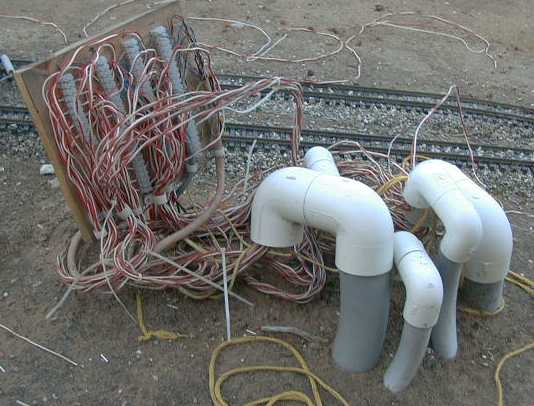 Much more important, the structure is designed to cover,
protect and conceal this awful mess of wiring right out in the middle
of my layout. It was my intention to build a structure like this from
the beginning, it has just taken me 4 years to do it. In the meantime,
the wiring connection board was covered with a scenic paint bucket.
Much more important, the structure is designed to cover,
protect and conceal this awful mess of wiring right out in the middle
of my layout. It was my intention to build a structure like this from
the beginning, it has just taken me 4 years to do it. In the meantime,
the wiring connection board was covered with a scenic paint bucket.
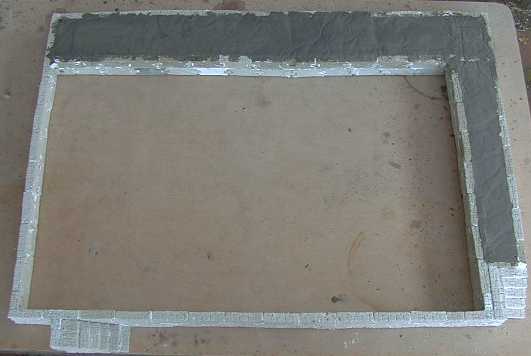 In
previous work with JigStones, I had used Liquid Nails to glue them
together. This time I decided to try Lexel, a significantly more
expensive, but also significantly stronger adhesive. This adhesive
worked out very well in this application. It cures to a more flexible
bond than Liquid Nails, but it also adheres to the cement blocks better
too.
In
previous work with JigStones, I had used Liquid Nails to glue them
together. This time I decided to try Lexel, a significantly more
expensive, but also significantly stronger adhesive. This adhesive
worked out very well in this application. It cures to a more flexible
bond than Liquid Nails, but it also adheres to the cement blocks better
too.
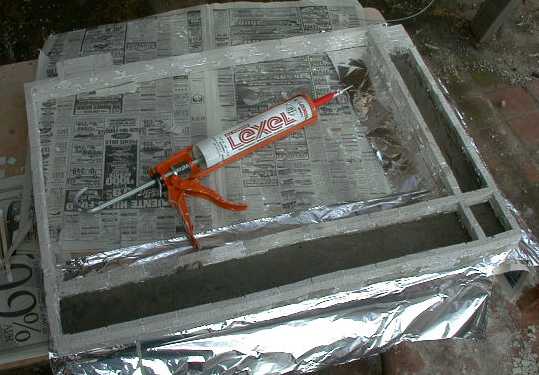 The docks were poured in cement inside
the foundation walls. A sheet of 1/8" hardware cloth is cast into the
dock surfaces to reinforce them. The docks in both of these photos were
cast in Quikrete Quick Set
cement. During the fit check shown in the next photo, the concrete
actually broke even though it was nearly cured. I broke the rest of the
larger section out and replaced it with RapidSet Cement All. When that set,
there were no more problems with broken concrete.
The docks were poured in cement inside
the foundation walls. A sheet of 1/8" hardware cloth is cast into the
dock surfaces to reinforce them. The docks in both of these photos were
cast in Quikrete Quick Set
cement. During the fit check shown in the next photo, the concrete
actually broke even though it was nearly cured. I broke the rest of the
larger section out and replaced it with RapidSet Cement All. When that set,
there were no more problems with broken concrete.
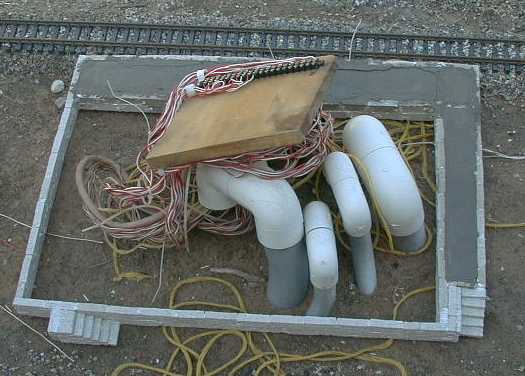 The foundation was placed around the wiring mess just to
make sure that it would fit properly. There is adequate clearance. The
cracks in the larger dock can be seen in this photo. By the time that I
got it back to the workbench, most of the larger dock section had
literally fallen out.
The foundation was placed around the wiring mess just to
make sure that it would fit properly. There is adequate clearance. The
cracks in the larger dock can be seen in this photo. By the time that I
got it back to the workbench, most of the larger dock section had
literally fallen out.
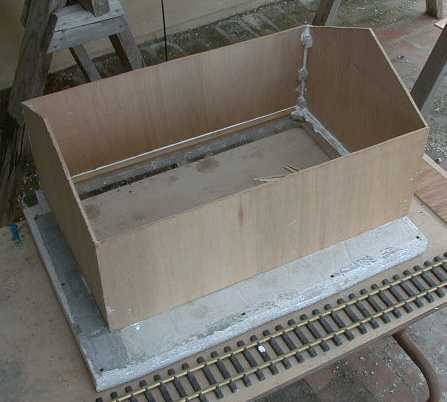 The shell of the building is made with 1/4"
mahogany plywood, commonly called door skin. This can be found at most
lumber yards in 4' x 8' sheets. Other kinds of plywood can be used as
well. Plywood is not normally a good material to use for outdoor
structures, but in this case it will be adequately protected. First, it
was sealed with acrylic clear coat inside and out after assembly.
Second, it will be covered with aluminum siding. Third, it is protected
from contact with the soil by the concrete building foundation. The
foundation was stiffened by a 1/4" x 1/2" redwood footer board attached
around the foundation with Lexel adhesive. The four major panels are
attached to the foundation and redwood footer with Lexel adhesive. The
corners of the shell are reinforced with small JigStones blocks
attached with Lexel.
The shell of the building is made with 1/4"
mahogany plywood, commonly called door skin. This can be found at most
lumber yards in 4' x 8' sheets. Other kinds of plywood can be used as
well. Plywood is not normally a good material to use for outdoor
structures, but in this case it will be adequately protected. First, it
was sealed with acrylic clear coat inside and out after assembly.
Second, it will be covered with aluminum siding. Third, it is protected
from contact with the soil by the concrete building foundation. The
foundation was stiffened by a 1/4" x 1/2" redwood footer board attached
around the foundation with Lexel adhesive. The four major panels are
attached to the foundation and redwood footer with Lexel adhesive. The
corners of the shell are reinforced with small JigStones blocks
attached with Lexel.
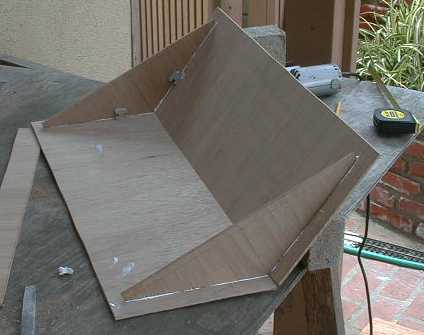 The roof was also made from door skin and
assembled with Lexel. The roof is designed to be removable and the end
frames just fit within the building shell. This means that the roof
must be lifted straight off or it will bind and jam. This is
intentional so that wind gusts may be able to move the roof around, but
will not be able to lift it off.
The roof was also made from door skin and
assembled with Lexel. The roof is designed to be removable and the end
frames just fit within the building shell. This means that the roof
must be lifted straight off or it will bind and jam. This is
intentional so that wind gusts may be able to move the roof around, but
will not be able to lift it off.
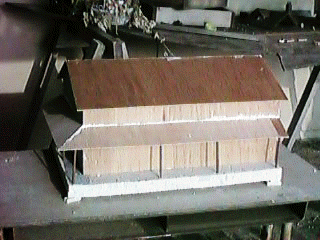 The shell was completed with the addition of an
awning roof over the two docks. The awning is supported by 1/4" x 1/4"
redwood posts that are set into footings left in the docks by a small
piece of similar material that was cast in place when the docks were
poured and then pounded out later.
The shell was completed with the addition of an
awning roof over the two docks. The awning is supported by 1/4" x 1/4"
redwood posts that are set into footings left in the docks by a small
piece of similar material that was cast in place when the docks were
poured and then pounded out later.
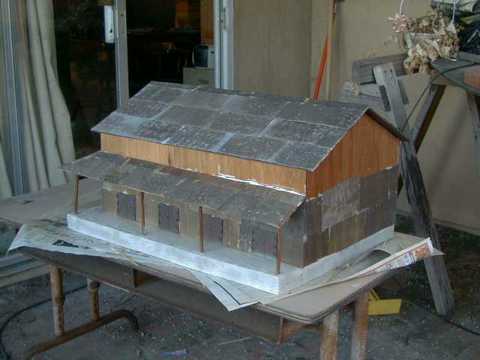 The corrugated can material is
attached to the shell with liberal amounts of Liquid Nails LN-901
adhesive. This material sticks to the cans and does a fair job of
holding them in place from the initial installation. If the can
material is slightly warped, it may pull away from the adhesive, but
after 15 minutes or so it can be pressed back into place and it'll
stick the second time.
The corrugated can material is
attached to the shell with liberal amounts of Liquid Nails LN-901
adhesive. This material sticks to the cans and does a fair job of
holding them in place from the initial installation. If the can
material is slightly warped, it may pull away from the adhesive, but
after 15 minutes or so it can be pressed back into place and it'll
stick the second time.
I had to quit construction at this point because I ran out of cans for the second time. The roof took one case worth or cans and the awnings and partially completed walls took another case worth. A third case worth of cans should be enough to finish the building.
 The double doors seen in
the last photo were replicated from a homemade master made from several
different mold made with different rubbers. I cast a total of 7 door
sets with 2 different resins and one more with concrete in 3 different
molds.
The double doors seen in
the last photo were replicated from a homemade master made from several
different mold made with different rubbers. I cast a total of 7 door
sets with 2 different resins and one more with concrete in 3 different
molds.
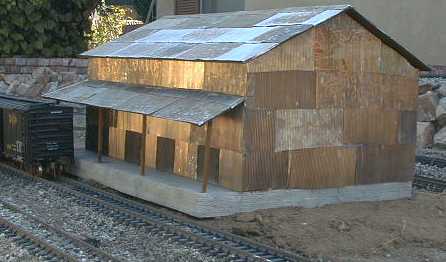 The completed warehouse is installed in its
final location. It is currently sitting on a sand foundation and is at
approximately the right height. All that the sand needs is a light
wetting and it'll set up hard and make a firm foundation for the
building.
The completed warehouse is installed in its
final location. It is currently sitting on a sand foundation and is at
approximately the right height. All that the sand needs is a light
wetting and it'll set up hard and make a firm foundation for the
building.
I had planned to paint the corrugated cans and then weather them using an airbrush. However, the as-annealed condition of the cans doesn't look half bad by itself so I have elected to delay painting and weathering until the sun has had a chance to do its work.
There are a few things left to do. I need to hang a sign from the awning as soon I can dream up a clever business name. I will also post a sign saying "office" above the office door. Also, if I can figure out how to do it, I am going to paint a badly faded "Mail Pouch" sign on the roof like was seen on many rural buildings during the first part of the 20th century.
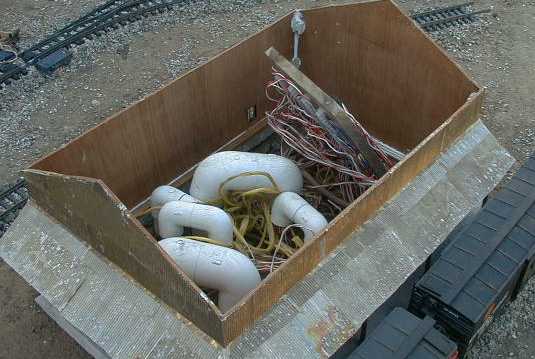 Getting back to the
original purpose of this building shows that it does exactly what it
was intended to. The wiring is completely covered and protected from
the weather yet is still easily accessible. The only thing to do is to
wait for the next wind storm to see if the roof blows off. The building
itself will probably not blow away because it weighs nearly 10 lbs.
Getting back to the
original purpose of this building shows that it does exactly what it
was intended to. The wiring is completely covered and protected from
the weather yet is still easily accessible. The only thing to do is to
wait for the next wind storm to see if the roof blows off. The building
itself will probably not blow away because it weighs nearly 10 lbs.
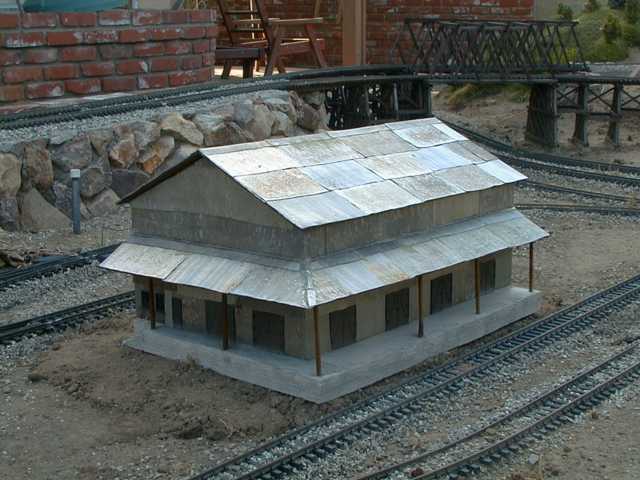 After just two weeks in the summer sun, the
brown cast of the cans has been virtually bleached out. Maybe it'll
take some weathering after all, but I'm going to let it sit all summer
before starting weathering to see what really needs to be done.
After just two weeks in the summer sun, the
brown cast of the cans has been virtually bleached out. Maybe it'll
take some weathering after all, but I'm going to let it sit all summer
before starting weathering to see what really needs to be done.
10 June 00.
© 2000-2002 George Schreyer
Created June 10, 2000
Last Updated August 10, 2002